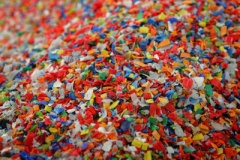Difference between revisions of "Plastics"
| Line 59: | Line 59: | ||
|1. | |1. | ||
|(a) and (c) Adversely affects processing and the general appearance of moulding. | |(a) and (c) Adversely affects processing and the general appearance of moulding. | ||
| + | |- | ||
|(b) As for (a) but with additonal deterioration of electrical properties. | |(b) As for (a) but with additonal deterioration of electrical properties. | ||
| + | |- | ||
|(d) Drying rectifies damage due to (a) and (c) but not that caused by (b). | |(d) Drying rectifies damage due to (a) and (c) but not that caused by (b). | ||
|- | |- | ||
Revision as of 09:55, 24 June 2013
| Infobox on Plastics | |
|---|---|
| Example of Plastics |  |
| Facts | |
| Origin | - |
| Stowage factor (in m3/t) | - |
| Humidity / moisture | - |
| Ventilation | - |
| Risk factors | See text |
Plastics
Description / Application / Shipment and storage / Risk factors
Plastic materials which become contaminated with dust, dirt, etc., may, if such foreign matter cannot be separated, become useless for the production of high-grade articles. When this material is in dried form, moulding powders, etc., and is packed in paper bags, it is particularly liable to depreciation by reason of the bags coming into contact with foreign substances. Care is necessary in handling damaged bags to avoid contamination of the unexposed portion of the contents. The following are individual comments on various plastic materials for guidance in assessing the cause and extent of damage, and in the handling and treatment of plastic materials:
| The effect of damage by: | ||
| 1 | a) High humidity | |
| b) Salt water | ||
| c) Fresh water | ||
| d) Treatment, if any | ||
| 2 | a) Effect of damage by heat | |
| b) Treatment, if any |
Acetal Polymers
| 1. | (a), (b) and (c): All three causes render material unsuitable for use. |
| (d) | Vacuum drying would make material suitable for processing in case of (a) and (c) but not (b) |
| 2. | Melts at 165°C. Has a high thermal stability in air up to 100°C; will begin to degrade at approx. 190°C. |
Acrylic moulding material











